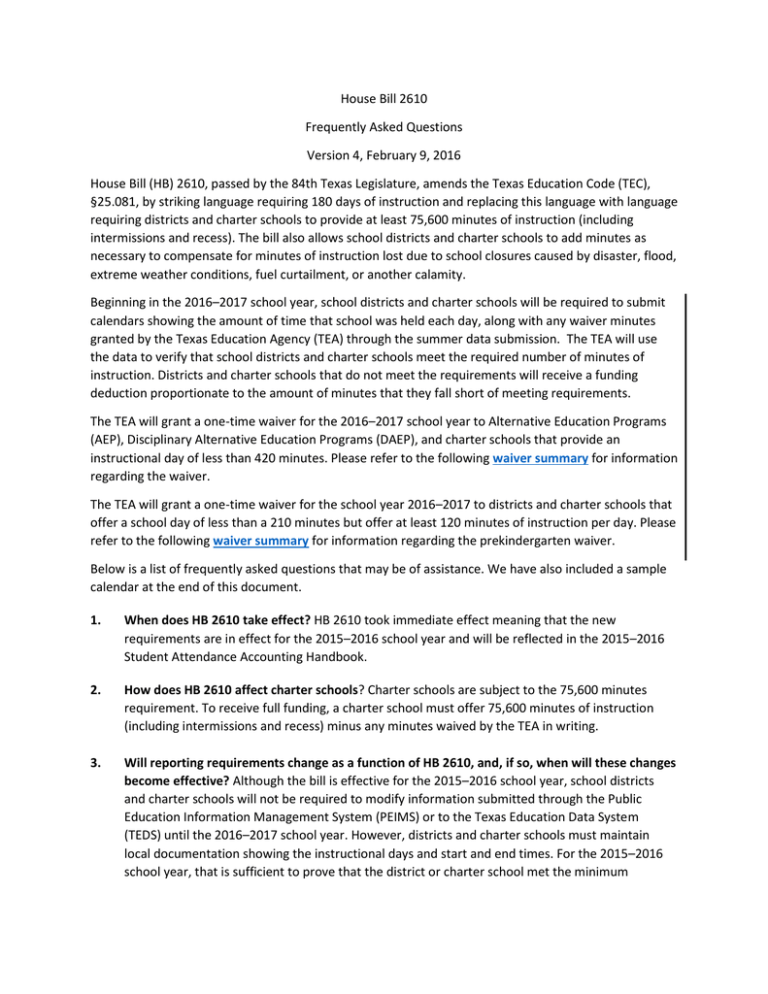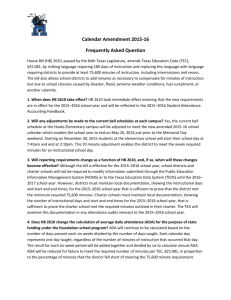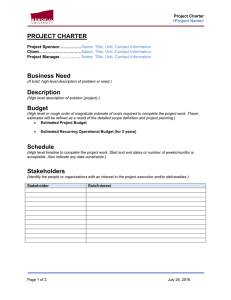House Bill 2610 - Texas Education Agency
advertisement

House Bill 2610 Frequently Asked Questions Version 4, February 9, 2016 House Bill (HB) 2610, passed by the 84th Texas Legislature, amends the Texas Education Code (TEC), §25.081, by striking language requiring 180 days of instruction and replacing this language with language requiring districts and charter schools to provide at least 75,600 minutes of instruction (including intermissions and recess). The bill also allows school districts and charter schools to add minutes as necessary to compensate for minutes of instruction lost due to school closures caused by disaster, flood, extreme weather conditions, fuel curtailment, or another calamity. Beginning in the 2016–2017 school year, school districts and charter schools will be required to submit calendars showing the amount of time that school was held each day, along with any waiver minutes granted by the Texas Education Agency (TEA) through the summer data submission. The TEA will use the data to verify that school districts and charter schools meet the required number of minutes of instruction. Districts and charter schools that do not meet the requirements will receive a funding deduction proportionate to the amount of minutes that they fall short of meeting requirements. The TEA will grant a one-time waiver for the 2016–2017 school year to Alternative Education Programs (AEP), Disciplinary Alternative Education Programs (DAEP), and charter schools that provide an instructional day of less than 420 minutes. Please refer to the following waiver summary for information regarding the waiver. The TEA will grant a one-time waiver for the school year 2016–2017 to districts and charter schools that offer a school day of less than a 210 minutes but offer at least 120 minutes of instruction per day. Please refer to the following waiver summary for information regarding the prekindergarten waiver. Below is a list of frequently asked questions that may be of assistance. We have also included a sample calendar at the end of this document. 1. When does HB 2610 take effect? HB 2610 took immediate effect meaning that the new requirements are in effect for the 2015–2016 school year and will be reflected in the 2015–2016 Student Attendance Accounting Handbook. 2. How does HB 2610 affect charter schools? Charter schools are subject to the 75,600 minutes requirement. To receive full funding, a charter school must offer 75,600 minutes of instruction (including intermissions and recess) minus any minutes waived by the TEA in writing. 3. Will reporting requirements change as a function of HB 2610, and, if so, when will these changes become effective? Although the bill is effective for the 2015–2016 school year, school districts and charter schools will not be required to modify information submitted through the Public Education Information Management System (PEIMS) or to the Texas Education Data System (TEDS) until the 2016–2017 school year. However, districts and charter schools must maintain local documentation showing the instructional days and start and end times. For the 2015–2016 school year, that is sufficient to prove that the district or charter school met the minimum required 75,600 minutes. The TEA will examine this documentation in any attendance audits relevant to the 2015–2016 school year. 4. Does HB 2610 change attendance-taking procedures? HB 2610 does not change attendancetaking procedures in that staff will still be required to take attendance at the same time each day. Students must be scheduled for and provided instruction at least two hours each day (excluding intermissions and recess) to be eligible to be coded for half-day attendance; students must be provided instruction at least four hours each day (excluding intermissions and recess) to be eligible to be coded for full-day attendance. 5. Does HB 2610 change the calculation of average daily attendance (ADA) for the purpose of state funding under the foundation school program? ADA will continue to be calculated based on the number of days present each six weeks divided by the number of days taught. Each calendar day represents one day taught, regardless of the number of minutes of instruction that occurred that day. The result for each six-week period will be added together and divided by six to calculate annual ADA. ADA will be reduced for failure to meet the required number of minutes per TEC, §25.081, in proportion to the percentage of minutes that the district or charter school fell short of meeting the 75,600 minute requirement. 6. What kinds of time count toward meeting the 75,600 minute requirement? HB 2610 specifies that intermissions and recesses count toward meeting the 75,600 minute requirement. Lunch is considered an intermission and will be counted toward meeting this requirement. 7. Have teacher contract requirements changed in conjunction with HB 2610? No. TEC, §41.401, still requires that teachers employed under a 10-month contract provide a minimum of 187 days of service. Districts and charter schools should consider this when creating calendars that are shorter than the traditional 180 days. 8. I have already been granted a waiver for the 2015–2016 school year. Is it still in effect? Yes. The TEA will honor all waivers previously granted that are in effect for the 2015–2016 school year. Each waiver day will count for 420 minutes of the total 75,600 minutes required under HB 2610. Waivers granted for an early release are worth up to 180 minutes, depending on the time students were released from school. 9. Is the TEA continuing to grant new waivers given HB 2610? The TEA is continuing to grant waivers. However, districts and charter schools should consider whether they need a waiver given the new language in HB 2610. If a district or charter school meets the 75,600 minute requirements without a waiver, it does not need to request a waiver related to student attendance and ADA (for example, staff development and missed instruction) from the TEA. We will notify districts and charter schools of any changes to policy related to HB 2610. 10. What should the district’s or charter school’s calendar include? The TEA encourages districts and charter schools to include additional minutes to account for bad weather or other missed school days related to health and safety concerns in their adopted calendar. Districts’ and charter schools’ calendars should equal at least 75,600 minutes including minutes waived for early release and/or staff development. 11. Does HB 2610 apply to an alternative campus that runs longer periods in a quarter system to enable students to make up classes necessary for graduation? Yes. A district and charter school must ensure that alternative education programs meet the requirements of HB 2610 (a total of 75,600 minutes of instruction, including intermissions and recess) for funding purposes. 12. How does HB 2610 affect the two- or four-hour rule for half days already scheduled? Do these scheduled half days count only for the time attended instead of as a half day? Students must be scheduled for and provided instruction for at least two hours each day (excluding intermissions and recess) to be coded as eligible for half-day attendance and scheduled for and provided instruction for at least four hours (excluding intermissions and recess) to be coded as eligible for full-day attendance. 13. Will there be a minimum number of minutes required for a class to count as a semester class or a full-year class? No. HB 2610 only requires districts and charter schools to provide a total of 75,600 minutes for instruction (including intermissions and recesses) per school year. 14. Would excess contact hours earned by any combination of special education and career and technical education (CTE) classes still be deducted from the student’s primary special education instructional setting? Yes. Any combination of CTE and special education services that exceeds six hours per day must be subtracted from the primary special education instructional setting. 15. Will the TEA grant a waiver if doing so still leaves my school short of meeting the 75,600-minute requirement? No. The TEA will only grant waivers if the sum of minutes in the school’s calendar and the minutes waived are at least equal to 75,600. For example, if a school district or charter school submits a calendar that includes 75,000 minutes and asks for one waiver day, the waiver will be denied because granting it would only bring the district or charter school to 75,420 (still short of the required 75,600 minutes). Any waivers granted, in addition to satisfying independent reasons for receiving the waiver, must be sufficient to bring the school district or charter school into compliance. 16. Can my school district or charter school change the calendar after the school year has started to make up minutes lost to an unforeseen event? Yes. You can add minutes to days remaining in the school year to make up for an unplanned event that caused school to be closed during the school year. 17. If I have a district level UIL competition (for example, band or basketball) and I want to close campuses down so students can attend, will those campuses have to makeup those missed days? If your district calendar has the missed days for UIL competition, bad weather makeup days, early release days, and staff development days built into the calendar and the 75,600 minutes are met by the time school has ended, then any missed days do not have to be made up. 18. If my district or charter school only has a prekindergarten campus, how many minutes does it need to meet to comply with HB 2610? If the campus is solely a prekindergarten campus and has only an a.m. or p.m. group of students, it would need to have a total of 37,800 minutes since prekindergarten is funded on a half day of ADA. With the exception of students that are prekindergarten and special education coded. 19. If a district adds minutes to the school day through the year to shorten its school year by a day or more, will the fact that it has and would report less days in the year cause it to receive less ADA funding (not receiving funding for the shorted days)? A district’s ADA will not be reduced based on number of days. However, if the district fails to meet the required 75,600 minutes according to the TEC, §25.081 (HB 2610), the district’s ADA will be reduced in proportion to the percentage of minutes that the district fell short in meeting the 75,600 minute requirement. Please note that for the 2015–2016 school year, the district will continue to report days in the Public Education Information Management System (PEIMS) or to the Texas Education Data System (TEDS) until the 2016–2017 school year. Districts must maintain local documentation that shows the instructional days and start and end times for the 2015–2016 school year that is sufficient to prove that the district met the minimum required 75,600 minutes. 20. Do I still need to apply for staff development waivers if I exceed 75,600 minutes? We believe the intent of HB 2610 was to relieve the need for waiver days. For staff development days, if the district or charter school meets (or exceeds) the 75,600 minute requirement without the waiver, it does not need to request a waiver. However, for early release, districts are still subject to the 7 hour day (420 minutes) requirement of TEC, §25.082, so a waiver must be requested if your school day is less than 7 hours (420 minutes) in length. 21. Is the requirement a district requirement or is it based on individual campuses, our elementary ends school 20 minutes before our high school, do I compute these times separately? The requirement is a district requirement that is to be applied to individual campuses. Based on your example you would have 2 different tracks of time for each campus. 22. If the district calendar meets the 75,600 minutes requirement, would the district receive ADA for the additional minutes if students remain in school? (For example: the district meets the required minutes by May 18th, has 4,900 minutes left, and wants to use the additional minutes for credit recovery, early summer school, etc. since teachers are still on duty). No, HB 2610 only requires districts and charter schools to provide a total of 75,600 minutes for instruction (including intermissions and recesses) per school year. Therefore, districts and charter schools will not receive funding for minutes in excess of 75,600. 23. Our prekindergarten students (3 and 4 year old program) attend school for 6 hours per day. Since we get funded for half days, do have to comply with HB 2610’s mandatory instructional minute guideline of 75,600 or 37,800 (half of the calculation)? Prekindergarten classes must operate on a half-day basis which would be half of the required number of minutes (37,800) unless funding other than Foundation School Program funding is used to offer a full-day prekindergarten program, as prekindergarten is state-funded only as a half-day program. In general, students who meet the eligibility requirements for the PK program should be coded as eligible for half-day attendance (ADA eligibility code 2) and not as eligible for full-day attendance (ADA eligibility code 1). Districts and charter schools that offer prekindergarten programs of less than 210 minutes per day may apply for a waiver of the requirement for the 2016–2017 school year. Please refer to the following waiver summary for information regarding the pre-k waiver. 24. Now that we are required to meet the 75,600 minutes minimum, are we also bound by a certain number of days? For instance, if we can reach the required 75,600 minutes in 169 instructional days, would we need a waiver to have less than the 178 days we currently have? Since HB 2610 replaced the language and the requirement for 180 days of instruction with 75,600 minutes of instruction (including intermissions and recess), districts and charter schools are no longer bound by days with regard to instruction. However, TEC, §41.401, still requires that teachers employed under a 10-month contract provide a minimum of 187 days of service. Districts should consider this when creating calendars that are shorter than the traditional 180 days. Also, note that when creating your calendar the school year cannot end before May 15th. 25. We provide tutorials to students from 7:45 am to 8:00 am every morning. All teachers are required to be here by that time to provide these services. Our bell to go to first period rings at 8:00 am. Can we count the 15 minutes per day of tutorial toward our instructional day? The minutes for the school day start when the first bell rings at 8:00 am to convene school. The district may consider adjusting the bell schedule to capture the 15 minutes described in the scenario. 26. I have a campus that attends school extra minutes Monday through Thursday. Can the campus release students early every Friday since we will meet the required 75,600 minutes by May 20th of the school year? Districts are still subject to the 7 hour day requirement (420 minutes) of TEC, §25.082, so a waiver must be requested if the school day is less than 7 hours (420 minutes) in length. The TEA will not grant more than six days of early release waivers per school year. 27. Our prekindergarten stand-alone campus has two groups daily (an a.m. and a p.m. group). Each group meets for 130 minutes daily for a total of 260 minutes per day. Are we in compliance if we combine the a.m. and p.m. group to the meet the required 37,800 minutes? Each prekindergarten group (a.m. and p.m.) must have 37,800 minutes for the school year to comply with the requirements of HB 2610. Districts and charter schools that offer pre-k programs of less than 210 minutes per day may apply for a waiver of the requirement for the 2016–2017 school year. Please refer to the following waiver summary for information regarding the pre-k waiver. 28. Will the TEA grant waivers for districts and charter schools that offer programs that provide an instructional day of less than 420 minutes? The TEA will grant a one-time waiver for the 2016–2017 school year for AEP, DAEP, and charter schools that offer less than 420 minutes per school day. Please refer to the following waiver summary for information regarding the waiver.


